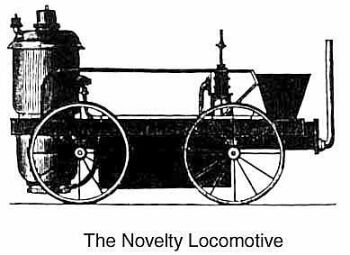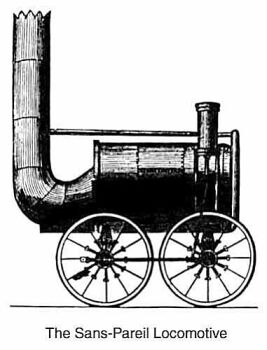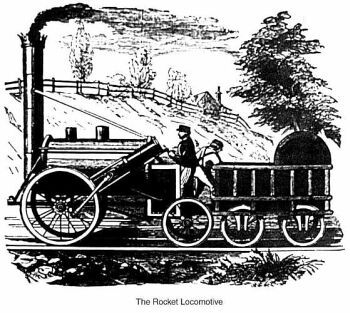|
CHAPTER XI
COMPETITION FOR PRIZES
A GREAT interest was manifested at Liverpool and throughout
the country at the approaching competition. Engineers and scientific
men arrived from all quarters of the world, to witness the trial
of mechanical skill about to be displayed.
On the day appointed the following engines were upon the spot,
and entered for the prize:

THE NOVELTY, made by Messrs. Braithwaite and Ericsson.

THE SANS-PAREIL, made by Mr. Timothy Hackworth.

THE ROCKET, made by Messrs. Stephenson and Co., Newcastle.
THE PERSERVERENCE, made by Mr. Burstall.
The day of trial was changed from the 1st to the 6th of October,
in order to give the new engines time to get in good working-order.
Many thousand spectators were present. The Rocket, although not
the first entered, was, nevertheless, the first ready for the
trial. The piece of road to be used for the occasion was two miles
in length, upon which the locomotives were to travel to and fro.
The distance run by the Rocket was about twelve miles in fifty-three
minutes. The Novelty was next tried. It was a very complicated
machine, carrying the water and fuel upon the same wheels as the
engine, and the whole weighed three tons one hundred lbs. On account
of some difficulty in determining the load she was to draw, she
was not tested like the Rocket, but was run over the road, making
sometimes twenty-four miles per hour.
The Sans-pareil was next tried, but no particular experiment
was made on that day.
The contest was postponed until the following day, but, before
the judges arrived upon the ground, the bellows for creating the
draught or blast in the Novelty gave way, and it was incapable
of going through its performance. A defect was also discovered
in the boiler of the Sans-pareil, and time was allowed to get
it repaired. Meantime, Mr. Stephenson, to lessen the disappointment
to the vast crowd assembled to witness these experiments by the
delay, brought out the Rocket and attached it to a coach containing
thirty persons, and ran it along the road at the rate of from
twenty-six to thirty miles an hour, much to the delight and gratification
of the spectators. The judges then ordered the Rocket to be in
readiness the following morning to go through its trial according
to the prescribed conditions.
On the morning of October 8, 1829, the Rocket was again upon
the road for the contest. The fire-box was filled with coke, the
fire lighted, and the steam raised until it lifted the safety-valve
loaded to the pressure of fifty pounds to the square inch. These
preparations occupied fifty-seven minutes. The engine being started
on its journey, dragged after it thirteen tons' weight in carriages
or wagons, and made the first ten trips backward and forward upon
the two miles of the road, running the thirty-five miles, including
stoppages, in one hour and forty-eight minutes.
The second ten trips were in like manner accomplished in two
hours and three minutes. The maximum velocity of the Rocket during
the trial-trip was about twenty-nine miles an hour, or three times
the speed that one of the judges had declared to be the limit
of possibility.
Neither the Novelty nor the Sans-pareil was ready for trial
until the 10th. The weight of carriages attached to the Novelty
was only seven tons. In starting, the engine went off in fine
style for the two miles, but, on returning, the pipe for the forcing-pump
burst and put an end to the trial. The pipe having been repaired,
the engine made a trial-trip, without a load, and is said to have
run from twenty-four to twenty-eight miles an hour.
The Sans-pareil was not ready until the l3th, and, when the
boiler and tender were filled with water, it weighed 400 lbs.
beyond the prescribed conditions of four-wheel engines; but nevertheless
the judges allowed it to run upon the same footing as the others,
and it traveled at the average speed of fourteen miles an hour,
with its load; but at the eighth trip the cold-water pipe got
out of order, and it could proceed no farther. It was then determined
by the judges to award the prize to the successful engine on the
following day, October l8th.
When the trial commenced, the Novelty again broke down. The
builder of the Sans-pareil requested an other trial, but the judges
decided that she was beyond the prescribed weight, and besides
consumed and wasted too much coke to make her a successful competitor,
using 692 lbs. of coke per hour when running.
The Perseverance was then tried for the first time, and found
unable to move more than five or six miles an hour.
The Rocket was the only engine that had performed all the stipulated
conditions, and the prize of £500 was accordingly awarded
to its makers. The Rocket had eclipsed all other engines that
had as yet been constructed, and determined the question of the
use of locomotive power upon the Liverpool and Manchester Railroad.
Our narrative now brings us down to the period when locomotives
were first introduced into the United States, A. D. 1829. Two
important railroads had been commenced, and were in successful
working-order, as far as they had been built. But horse-power
upon levels, and stationary engines upon steep inclines, were
the only powers resorted to. Locomotives had not yet been introduced.
The experiments in England had been heard of in this country,
and were frequently discussed by those interested in the success
of railroads.
The experiments of Mr. Stephenson had been carefully watched.
His name and fame, as an eminent engineer, were familiar to the
minds of the people of this country. His success with his "Rocket"
excited the liveliest interest here, and equally as much so as
in England. His bearing of the £500 prize was hailed with
rapture by thousands in America, who admired him for his genius
and indomitable perseverance.
We will now leave Mr. Stephenson and his improvements in England,
and turn to the period of 1829, in the United States, when, although,
as before said, two important railroads and two coal-roads were
in successful progress, or in operation in different sections
of the country, yet, as in England in its earliest day, for mining
purposes, only horse-power was used, and no attempt had been made
to construct a locomotive, nor had one been imported from abroad.
Table of Contents
| Antebellum Page | Site
Contents
|







